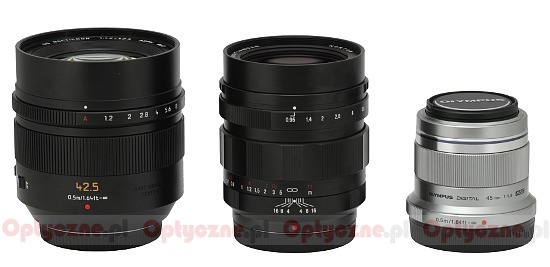Voigtlander Nokton 42.5 mm f/0.95
3. Build quality
Now we would like you to turn your attention to those features that make the Voigtlander stick out in this group. Firstly its minimal focus distance amounts to 0.23 of a meter. It is a result impossible to achieve by any other classic portrait lens, either designed for small sensors or for full frame. The second difference is an aperture with as many as 10 diaphragm blades.
Looking at the photo below you see a comparison between the tested lens, the Panasonic and the Olympus 1.8/45.
Please Support UsIf you enjoy our reviews and articles, and you want us to continue our work please, support our website by donating through PayPal. The funds are going to be used for paying our editorial team, renting servers, and equipping our testing studio; only that way we will be able to continue providing you interesting content for free. |
- - - - - - - - - - - - - - - - - - - - - - - - - - - - - - - - - - - - - - - - - - - - - - - -
 |
If you’ve ever had any Voigtlander in your hand you won’t be disappointed with the Nokton 0.95/42.5 either – you deal here with only metal and glass.
The lens starts with a metal, short, Micro 4/3 mount. There are no contacts so a camera body won’t be fed any information about focal lengths and aperture values and won’t save those parameters in EXIF. A rear element is 27 mm in diameter, situated more or less on the same level as the mount when the focus is set at infinity. When you pass to the minimum focusing distance the element hides inside the lens body almost 2 cm deep.
 |
The metal, black casing features first a depth of field scale, with markings at f/16, f/8 and f/4.0 aperture, and, on the other side, a Micro 4/3 logo and an inscription “Lens made in Japan”. Further on, there is a manual focus ring, 23 mm wide. Most of it is covered by ribbing and shallow grooves for fingers. On the rest of the ring you can find a distance scale, expressed in meters and inches/feet. The ring works perfectly well – it is smooth and well-damped to operate across the range. Running through the whole scale takes a turn through as much as 280 degrees, allowing you very precise settings.
 |
Behind the manual focus ring there is a big part of the lens which extends noticeably when you pass to the minimum focusing distance. It features an aperture control ring, 7 mm wide. The aperture can be changed every 0.5 EV set using that ring only; contrary to the Voigtlanders SL II for full frame cameras there is no electronic communication between the lens and a camera body. The aperture ring, though, performs beyond reproach.
The front element of the lens is 45 mm in diameter, surrounded by an inscription with the name and the parameters of the lens and a non-rotating filter thread, with a diameter of 58 mm.
 |
The optical construction of the lens consists of 11 elements positioned in 8 groups. One of them was made of SHR glass (Super High Refractive) and another one is aspherical. Inside you can also find an aperture with ten diaphragm blades which can be closed down to f/16.
Buyers get both caps and a hood in the box.
 |






